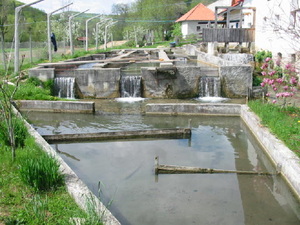They may be bony, but trout are a popular and tasty freshwater fish, and trout farming is now a major industry. Even the United States, which is hardly a leading consumer of fish (at least on a per capita footing) raises thousands of tons of trout every year. Almost 6,000 tons of trout is eaten in America every year, with 95% of it being provided by aquaculture. In Britain, where trout is much more popular, 16,000 tons of farmed trout is eaten each year.
Aquaculture like trout farming is distinct from operating a fish hatchery. The latter raises fish to a juvenile state in captivity, and then releases them into the wild. Fish farms, on the other hand, raise the fish to adulthood for processing and consumption. Like cattle ranches, hog farms or chicken farms, the fish are kept in captivity for their entire lives.
One of the most interesting aspects of trout farming is that it is an enterprise that lends itself to producers great and small, making it an ideal enterprise for a hobby farm. Trout farms consist of either closed ponds and tanks or erecting pens in a river, or sometimes both. Once upon a time, virtually the entire U.S. output of farmed trout came from farms using pens along a 30-mile run of the Snake River in Idaho.
Trout farms demand huge quantities of clean, cool water. Under most circumstances, even if the farm is not built in a river, it is best to be located near one and have the suitable access or water rights. For those who cannot get access to a river, a suitable spring or well can do the job. The best water temperature for farming trout is between 55 and 58 F, making large stretches of the U.S. unsuitable for this purpose (the river water is just too warm). You can still farm trout in warmer water, but they do not grow as well and that reduces their profit potential greatly. Another advantage of the colder water is that it holds more oxygen, which is important in an aquaculture pen that is jam-packed with fish.
There are environmental criticisms of trout farming, just as there are with factory farms for pigs, chickens and cattle. Fish wastes are often forgotten under wild circumstances, but large numbers of densely concentrated trout produce a lot of poo. Some farmers deal with their wastewater problem and their water supply problem in one go by constructing their own water reclamation projects. However, there are also problems with disease and parasites among the farmed trout getting out into the wild trout population. Farmed trout are all more vulnerable to red mouth, fish lice, intestinal worms, gill bacteria and fungal infections than wild trout, and like factory farms serve as something of a petri dish for these maladies.
Many trout farms are small-scale operations set in or near rivers and springs, and it does not require a lot of capital to open one. A fish farm turning out one ton of trout per year can be started for around $3,500. If you have the right climate, easy access to water, and plenty of space, a trout farm might just be the garage business you have been looking for.
Sources: essortment.com/all/troutfarming_rsen.htm; motherearthnews.com/Organic-Gardening/1983-09-01/Small-Scale-Trout-Farming.aspx; britishtrout.co.uk/explain.htm; wvu.edu/~agexten/aquaculture/2003forum/TroutFarm101.pdf
